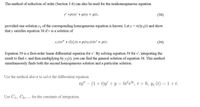
Calculus: Early Transcendentals
8th Edition
ISBN: 9781285741550
Author: James Stewart
Publisher: Cengage Learning
expand_more
expand_more
format_list_bulleted
Concept explainers
Question

Transcribed Image Text:The method of reduction of order (Section 3.4) can also be used for the nonhomogeneous equation
y" +p(t)y' + g{t}y = g(t).
(38)
provided one solution yı of the corresponding homogeneous equation is known. Let y = r(t)y) and show
that y satisfies equation 38 if v is a solution of
y1(O" + (2y, ) + plt)yO = g(0).
(39)
Equation 39 is a first-order linear differential equation for r'. By solving equation 39 for v, integrating the
result to find v, and then multiplying by y1(O. you can find the general solution of equation 38. This method
simultaneously finds both the second homogeneous solution and a particular solution.
Use the method above to solve the differential equation
ty" – (1+t)y' +y = 5t°e, t > 0, y1 (t) = 1+t.
Use C1, C2, ... for the constants of integration.
Expert Solution
This question has been solved!
Explore an expertly crafted, step-by-step solution for a thorough understanding of key concepts.
This is a popular solution
Trending nowThis is a popular solution!
Step by stepSolved in 4 steps with 3 images

Knowledge Booster
Learn more about
Need a deep-dive on the concept behind this application? Look no further. Learn more about this topic, calculus and related others by exploring similar questions and additional content below.Similar questions
- This is the first part of a two-part problem. Let P=[-: 1 5₁(t) = [(41) 5₂(t) = - sin(4t). a. Show that y₁ (t) is a solution to the system ÿ' = Pÿ by evaluating derivatives and the matrix product y(t) = = 0 [1] -4 Enter your answers in terms of the variable t. -4 sin(4t) -4 cos(4t)] ÿ₁ (t) [181-18] b. Show that y₂ (t) is a solution to the system ÿ' = Pÿ by evaluating derivatives and the matrix product Enter your answers in terms of the variable t. 04] 32(t) = [-28]|2(t) 181-181arrow_forwardAs a specific example we consider the non-homogeneous problem y" + 6y' + 8y = (1) The general solution of the homogeneous problem (called the complementary solution, Yc Ay₁ + By2 ) is given in terms of a pair of linearly independent solutions, Y₁, Y2. Here A and B are arbitrary constants. Find a fundamental set for y” + 6y' + 8y = 0 and enter your results as a comma separated list e^(-2x),e^(-4x) (2) Choose particula Y₁, Y2 in the fundamental set such that the W(x) is positive. Then W (x) 2e^(-6x) U 1 = If your W (x) is negative, then you need to switch your choise of y₁ and y2 and recalculate your W(x). The y₁= e^(-2x) ՂԱԶ √= With this appropriate order we are now ready to apply the method of variation of parameters. -Y₂(x) f(x) W(x) y = Yc + Yp and the y₂2 Y₁(x)f(x) W(x) S [21 dx -cos(e^(2x)) = dx = And combining these results we arrive at = S S e^(-4x) = 2e^(4x)sin(e^(2x)) dx 4 sin(e²x) dx = = = Ур (3) Finally, using A and B for the arbitrary constants in yc, the general solution…arrow_forwardSolutions, if they exist, of equations of the form an(x)y(m) (x) + an-1(x)y(n-1)(x)+ ... + a1 (x)y'(x) + ao(x)y(x) = f(x) are completely described by n linearly independent functions. Please, stop posting the same copied solution from chegg. I need to prove this is false using the EXISTENCE AND UNIQUENESS THEOREM. I know the answer, please just explain the E&U aspect of it.arrow_forward
arrow_back_ios
arrow_forward_ios
Recommended textbooks for you
 Calculus: Early TranscendentalsCalculusISBN:9781285741550Author:James StewartPublisher:Cengage Learning
Calculus: Early TranscendentalsCalculusISBN:9781285741550Author:James StewartPublisher:Cengage Learning Thomas' Calculus (14th Edition)CalculusISBN:9780134438986Author:Joel R. Hass, Christopher E. Heil, Maurice D. WeirPublisher:PEARSON
Thomas' Calculus (14th Edition)CalculusISBN:9780134438986Author:Joel R. Hass, Christopher E. Heil, Maurice D. WeirPublisher:PEARSON Calculus: Early Transcendentals (3rd Edition)CalculusISBN:9780134763644Author:William L. Briggs, Lyle Cochran, Bernard Gillett, Eric SchulzPublisher:PEARSON
Calculus: Early Transcendentals (3rd Edition)CalculusISBN:9780134763644Author:William L. Briggs, Lyle Cochran, Bernard Gillett, Eric SchulzPublisher:PEARSON Calculus: Early TranscendentalsCalculusISBN:9781319050740Author:Jon Rogawski, Colin Adams, Robert FranzosaPublisher:W. H. Freeman
Calculus: Early TranscendentalsCalculusISBN:9781319050740Author:Jon Rogawski, Colin Adams, Robert FranzosaPublisher:W. H. Freeman
 Calculus: Early Transcendental FunctionsCalculusISBN:9781337552516Author:Ron Larson, Bruce H. EdwardsPublisher:Cengage Learning
Calculus: Early Transcendental FunctionsCalculusISBN:9781337552516Author:Ron Larson, Bruce H. EdwardsPublisher:Cengage Learning

Calculus: Early Transcendentals
Calculus
ISBN:9781285741550
Author:James Stewart
Publisher:Cengage Learning

Thomas' Calculus (14th Edition)
Calculus
ISBN:9780134438986
Author:Joel R. Hass, Christopher E. Heil, Maurice D. Weir
Publisher:PEARSON

Calculus: Early Transcendentals (3rd Edition)
Calculus
ISBN:9780134763644
Author:William L. Briggs, Lyle Cochran, Bernard Gillett, Eric Schulz
Publisher:PEARSON

Calculus: Early Transcendentals
Calculus
ISBN:9781319050740
Author:Jon Rogawski, Colin Adams, Robert Franzosa
Publisher:W. H. Freeman


Calculus: Early Transcendental Functions
Calculus
ISBN:9781337552516
Author:Ron Larson, Bruce H. Edwards
Publisher:Cengage Learning